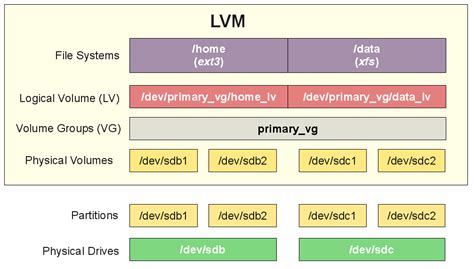lvm pv vg lv | linux vg lvm pv vg lv In LVM, the physical devices are Physical Volumes (PVs) in a single Volume Group (VG). LVM RAID supports RAID 0, RAID 1, RAID 4, RAID 5, RAID 6 and RAID 10. See . Yes, they have non-smoking rooms. Never had a smoky-room problem at Harrah's...not to worry.
0 · vgcreate
1 · resize vg lvm
2 · rename vg lvm
3 · pv vg lv linux
4 · lvm vgcreate
5 · linux vg
6 · linux lvm
7 · archlinux lvm
LOUIS VUITTON Official USA site - Locate Louis Vuitton stores in the USA and in the World and discover special services, product offer and opening hours. Skip to main content. Complimentary Saturday Delivery for eligible zip codes only: Order by 5/10 at 12pm ET to receive by 5/11. . The GO-14. Capucines. GO-14. LV Icons. New In. Monogram .
When you create a logical volume (LV) within a VG, LVM allocates physical extents on the PVs. The logical extents within the LV correspond one-to-one with physical extents in the VG. You .A physical volume (PV) is a physical storage device or a partition on a storage device that L.
LVM, or Logical Volume Management, is a storage device management technology that gives users the power to pool and abstract the physical layout of component storage devices for . Most modern Linux distributions are LVM-aware to have their root file systems on a logical volume. Logical Volume Management (LVM) manages three main components: .In LVM, the physical devices are Physical Volumes (PVs) in a single Volume Group (VG). LVM RAID supports RAID 0, RAID 1, RAID 4, RAID 5, RAID 6 and RAID 10. See .
A Logical Volume (LV) is a virtual block device that can be used by the system or applications. Each block of data in an LV is stored on one or more PV in the VG, according to algorithms . In this tutorial, you'll learn the concept of LVM, its components and why you should be using it. I won't be limited to just the theoretical explanation. I'll also show hands-on examples for creating and managing LVMs in Linux.A physical volume (PV) is a physical storage device or a partition on a storage device that LVM uses. During the initialization process, an LVM disk label and metadata are written to the .
PV: Physical Volumes. This means the hard disk, hard disk partitions, RAID or LUNs from a SAN which form "Physical Volumes" (or PVs). VG: Volume Groups. This is a collection of one or . Volume Group (VG): Combine multiple PVs into a flexible pool of storage. Logical Volume (LV): Virtual partitions within a VG that users can interact with (think of them as disk .When you create a logical volume (LV) within a VG, LVM allocates physical extents on the PVs. The logical extents within the LV correspond one-to-one with physical extents in the VG. You do not need to specify the PEs to create LVs.
LVM, or Logical Volume Management, is a storage device management technology that gives users the power to pool and abstract the physical layout of component storage devices for flexible administration.

vgcreate
Most modern Linux distributions are LVM-aware to have their root file systems on a logical volume. Logical Volume Management (LVM) manages three main components: Physical Volume (PV) is the partition of the physical disks. Volume Group (VG) is a combination of multiple individual hard drives/or disk partitions into a single volume group. Overview on Logical Volume Manager. The Logical Volume Manager (LVM) provides tools to create virtual block devices from physical devices. LVM is a collection of one or more physical devices called Volume Group (VG), each physical device on the VG called a Physical Volume (PV).In LVM, the physical devices are Physical Volumes (PVs) in a single Volume Group (VG). LVM RAID supports RAID 0, RAID 1, RAID 4, RAID 5, RAID 6 and RAID 10. See Wikipedia:Standard RAID levels for details on each level.A Logical Volume (LV) is a virtual block device that can be used by the system or applications. Each block of data in an LV is stored on one or more PV in the VG, according to algorithms implemented by Device Mapper (DM) in the kernel.
In this tutorial, you'll learn the concept of LVM, its components and why you should be using it. I won't be limited to just the theoretical explanation. I'll also show hands-on examples for creating and managing LVMs in Linux.A physical volume (PV) is a physical storage device or a partition on a storage device that LVM uses. During the initialization process, an LVM disk label and metadata are written to the device, which allows LVM to track and manage it as part of the .
PV: Physical Volumes. This means the hard disk, hard disk partitions, RAID or LUNs from a SAN which form "Physical Volumes" (or PVs). VG: Volume Groups. This is a collection of one or more Physical Volumes. LV: Logical Volumes. LVs sit inside a Volume Group and form, in effect, a virtual partition. PE: Physical Extents.
Volume Group (VG): Combine multiple PVs into a flexible pool of storage. Logical Volume (LV): Virtual partitions within a VG that users can interact with (think of them as disk partitions). Physical Extent (PE): Smallest units of storage in a PV. Logical Extent (LE): Similar to PEs, but within LVs.When you create a logical volume (LV) within a VG, LVM allocates physical extents on the PVs. The logical extents within the LV correspond one-to-one with physical extents in the VG. You do not need to specify the PEs to create LVs. LVM, or Logical Volume Management, is a storage device management technology that gives users the power to pool and abstract the physical layout of component storage devices for flexible administration. Most modern Linux distributions are LVM-aware to have their root file systems on a logical volume. Logical Volume Management (LVM) manages three main components: Physical Volume (PV) is the partition of the physical disks. Volume Group (VG) is a combination of multiple individual hard drives/or disk partitions into a single volume group.
Overview on Logical Volume Manager. The Logical Volume Manager (LVM) provides tools to create virtual block devices from physical devices. LVM is a collection of one or more physical devices called Volume Group (VG), each physical device on the VG called a Physical Volume (PV).In LVM, the physical devices are Physical Volumes (PVs) in a single Volume Group (VG). LVM RAID supports RAID 0, RAID 1, RAID 4, RAID 5, RAID 6 and RAID 10. See Wikipedia:Standard RAID levels for details on each level.A Logical Volume (LV) is a virtual block device that can be used by the system or applications. Each block of data in an LV is stored on one or more PV in the VG, according to algorithms implemented by Device Mapper (DM) in the kernel. In this tutorial, you'll learn the concept of LVM, its components and why you should be using it. I won't be limited to just the theoretical explanation. I'll also show hands-on examples for creating and managing LVMs in Linux.
A physical volume (PV) is a physical storage device or a partition on a storage device that LVM uses. During the initialization process, an LVM disk label and metadata are written to the device, which allows LVM to track and manage it as part of the .PV: Physical Volumes. This means the hard disk, hard disk partitions, RAID or LUNs from a SAN which form "Physical Volumes" (or PVs). VG: Volume Groups. This is a collection of one or more Physical Volumes. LV: Logical Volumes. LVs sit inside a Volume Group and form, in effect, a virtual partition. PE: Physical Extents.

resize vg lvm
Don't know, but it's entirely possible, in fact to support many existing & future protocols. Pretty sure it uses https://en.wikipedia.org/wiki/CAN_FD - higher bandwidth, lower latency, etc. So i guess in the scheme of things .
lvm pv vg lv|linux vg



























